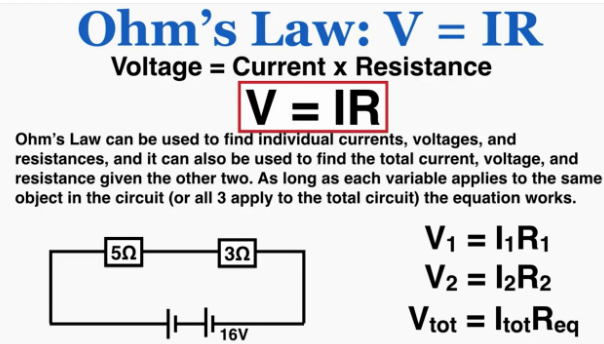v=ir is an important formula in electricity and science. v=ir shows the relationship between voltage, current, and resistance in an electric circuit. When you know any two of these, you can easily find the third. This makes v=ir very useful for students, hobbyists, and anyone who wants to understand how electricity works. Many people see complicated symbols in science books and get confused. But v=ir is actually easy to understand if you take it step by step.
v=ir helps us understand how electricity moves through wires and devices. Voltage is like the push that moves electric current. Current is the flow of electricity, and resistance is what slows it down. Using the formula v=ir, we can calculate how much voltage we need to make a current flow through a certain resistance. This knowledge is helpful for building simple circuits at home, fixing electronic devices, and learning more about energy. Even if you are new to electricity, v=ir can make the topic clear and interesting.
What is v=ir and Why It Matters
v=ir is a formula that comes from Ohm’s Law. Ohm’s Law is one of the most basic rules in electricity. The formula tells us that Voltage (V) equals Current (I) times Resistance (R). This helps us understand how electrical circuits work. When you know any two values, you can calculate the third. For example, if you know the voltage and resistance, you can find the current.
Understanding v=ir is important because it is the foundation of many electrical projects. Engineers, electricians, and students use this formula every day. Without knowing v=ir, it is very hard to design circuits or repair devices. Even in simple devices like a flashlight or a phone charger, v=ir is at work. Learning this formula can make science easier and more fun for everyone.
How to Use v=ir in Simple Circuits
Using v=ir is easy once you understand the parts. First, identify the voltage in your circuit. Voltage is like the push that moves the electricity. Next, measure the current, which is the flow of electrons. Finally, check the resistance, which is what slows down the electricity. Then you can use the formula v=ir to calculate the missing part.
For example, if a battery has 9 volts and a resistor has 3 ohms, you can find the current. Using v=ir, Current (I) = Voltage ÷ Resistance = 9 ÷ 3 = 3 Amps. This simple calculation helps you know how much electricity is moving. This is useful for building small projects, fixing broken electronics, or learning more about how devices work.
Understanding Voltage in v=ir
Voltage is the first part of v=ir. Voltage is measured in volts (V). You can think of voltage as the force that pushes electricity through wires. Without voltage, electricity cannot flow. Batteries, generators, and power outlets provide voltage.
In the v=ir formula, voltage equals the current multiplied by resistance. This means if you increase voltage, more current can flow, or more resistance can slow it down. Understanding voltage helps you design circuits safely. It also helps prevent problems like overheating or short circuits.
How Current Works with v=ir
Current is the flow of electricity. It is measured in amperes or amps (A). Current shows how much electricity is moving through a circuit. In v=ir, current is equal to voltage divided by resistance. This means current depends on both voltage and resistance.
If voltage is high and resistance is low, current will be strong. If voltage is low or resistance is high, current will be weak. Understanding current is very important for building circuits. It helps you know how much electricity flows and prevents damage to devices.
Resistance Explained in v=ir
Resistance is the part of a circuit that slows down electricity. It is measured in ohms (Ω). Resistors are used in circuits to control current. In v=ir, resistance equals voltage divided by current.
For example, if a voltage of 12 volts makes 2 amps of current flow, the resistance is 12 ÷ 2 = 6 ohms. Resistance protects devices from getting too much current. It is also useful when you want to make lights dimmer or slow down motors. Learning about resistance makes electricity safer and easier to understand.
Examples of v=ir in Real Life
v=ir is everywhere in daily life. For example, in a phone charger, the voltage pushes electricity into the battery. The current flows through wires, and the resistance controls the speed of charging.
In a flashlight, batteries provide voltage. The bulb has resistance, which controls how much current flows. Without understanding v=ir, these devices would not work correctly. Even big things like cars, computers, and home appliances use v=ir to function properly.
Easy v=ir Calculations for Beginners
v=ir can be calculated in simple steps. Remember the formula: Voltage = Current × Resistance. If you know two parts, you can find the third.
- To find voltage: V = I × R
- To find current: I = V ÷ R
- To find resistance: R = V ÷ I
These calculations are simple but very powerful. They help you design circuits, test devices, and understand electricity better. Using these calculations, even beginners can build small electronic projects at home.
v=ir Tips for Students and Hobbyists
For students and hobbyists, v=ir is very useful. Start with small circuits using batteries, wires, and bulbs. Measure voltage and current with a multimeter. Try changing resistors and see how current changes.
Always write down your results and check your calculations. This helps you understand how v=ir works in real life. With practice, using v=ir will become easy and fun. It also helps you learn other advanced topics in electronics.
Common Mistakes to Avoid with v=ir
Some common mistakes beginners make with v=ir include:
- Confusing voltage and current
- Using wrong units (volts, amps, ohms)
- Forgetting to measure resistance in a circuit
- Using too high voltage for a small device
Avoiding these mistakes makes learning electricity safe and easier. Always double-check your calculations before connecting circuits.
How v=ir Helps Fix Electronics
v=ir is useful for repairing electronics. For example, if a device is not working, you can measure voltage, current, and resistance. Using the formula, you can find where the problem is. Maybe a resistor is broken or the battery is weak.
By understanding v=ir, you can troubleshoot devices at home. It saves money and helps you learn more about electronics. Even professionals use this simple formula every day.
Fun Experiments Using v=ir
You can do simple experiments at home using v=ir. Try using batteries, wires, bulbs, and resistors. Measure voltage, current, and resistance. Change one part and see how it affects the circuit.
These experiments make learning fun. They also show that v=ir is not just a formula in books. It works in real life. Kids, students, and hobbyists can enjoy these hands-on experiments safely.
Advanced Tips to Master v=ir Quickly
Once you know the basics, you can try more advanced circuits. Use multiple resistors, different voltages, and bigger currents. Learn to read circuit diagrams. Practice calculating voltage drops and currents in complex circuits.
This helps you become confident with v=ir. You can build bigger projects, fix advanced electronics, and even prepare for science exams. Mastering v=ir is the first step to understanding electricity completely.
Conclusion
v=ir is a simple but powerful formula that shows the relationship between voltage, current, and resistance. It is the foundation of all electrical circuits. By learning v=ir, you can build circuits, fix devices, and understand how electricity works in everyday life. Even beginners can use it safely with small experiments and careful calculations.
FAQ
Q1: What does v=ir mean?
A: v=ir is a formula from Ohm’s Law. It shows that Voltage (V) equals Current (I) times Resistance (R).
Q2: Why is v=ir important?
A: It helps us understand how electricity flows in circuits. It is used in electronics, repairs, and science learning.
Q3: How do I calculate current using v=ir?
A: Current (I) = Voltage (V) ÷ Resistance (R).





